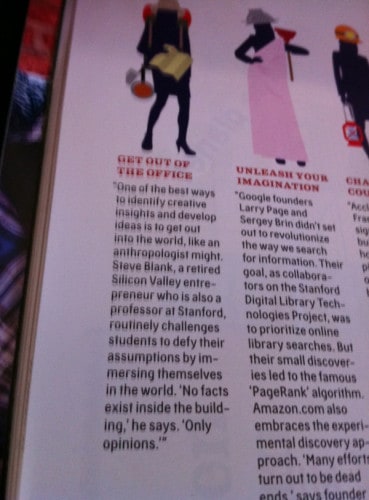Thanks to Patrick Vlaskovits, a guest in my Podcast episode #99, for posting a photo of a Southwest Airlines magazine blurb about Steve Blank, author of the outstanding book The Four Steps to the Epiphany on “customer development” for Lean Startups.
The item about the importance of getting out of the office applies to entrepreneurs as well as it does to a manager or leader in any hospital or business.
Here is Patrick's photo of the article (the left column):
The article mentions anthropology, a key contributor to the IDEO design methodology that involves observing customers living their everyday lives, much as Toyota has done in its own product development efforts.
Get out of your office. Go and see. Don't make assumptions – look for facts and reality in the “gemba” (the Japanese word for “the real place”).
Assumptions (and guesses) lead to all sorts of waste and bad decisions. It leads to employees getting demoralized (their leaders are out of touch) and it leads to startups going in the wrong direction if they are making guesses instead of really understanding their customers.
Such a simple idea, but so rarely practiced.
What are you doing to get out of the office? Is “we don't have time” a common excuse? If so, what can you do to free up time?
![]() photo credit: Môsieur J. [version 5.1.1]
photo credit: Môsieur J. [version 5.1.1]
Please scroll down (or click) to post a comment. Connect with me on LinkedIn.
Let’s build a culture of continuous improvement and psychological safety—together. If you're a leader aiming for lasting change (not just more projects), I help organizations:
- Engage people at all levels in sustainable improvement
- Shift from fear of mistakes to learning from them
- Apply Lean thinking in practical, people-centered ways
Interested in coaching or a keynote talk? Let’s talk.
Join me for a Lean Healthcare Accelerator Trip to Japan! Learn More







![Gemba Claus is Comin’ to Town! [An Original Song]](https://www.leanblog.org/wp-content/uploads/2023/12/gemba-claus-lean-blog.jpg)



It really is such a simple and powerful concept. The larger the organization, the less I see the leaders and managers stuck in their offices.
The challenge is that they end up focusing on what makes the factory’s job easier, and it usually has nothing with satisfying the customers needs. In the end, the company spends hundreds of hours and thousands (or millions) of dollars on projects that often make it harder for their customers to buy from them.
Business starts and ends with our customers.
Brandt – are you saying that you think managers at bigger companies do a better job of getting out of the office?
My experience is quite the opposite, that big companies have their manager’s stuck in their office and meetings most of the time.
You can, of course, have that dysfunction in small companies, but I think it’s more prevalent in larger organizations.
Get in dialog with the customer, whether on the phone, Twitter, Facebook, in the street or a conference – that’s the Gemba of the future.
The world is getting flatter and Gemba moves out of the company ;-)
Proponents of the formal “Customer Development” methodlogy often make the case that, although we have technology, that the interaction with customers and potential customers is much richer when it is done in person. For one, you gain the perspective of body language and other info that cannot be picked up well via Twitter, email, or phone even. Secondly, going to your customer’s “gemba” allows you to truly understand a “day in the life” and their real needs.
In the auto industry, Toyota famously sent their chief engineer from Japan to the U.S. and Canada to drive on our roads and to basically live with customers. I bet he learned a lot more than doing a web-based survey of those customers…
So I’m clearly not anti-technology, but I think we have to make the best use of different technologies, including our shoes and our eyeglasses.
The things you learn by seeing are so much richer than is normally gleaned from surveys. Surveys are fine for tracking results, seeing areas that might need further investigations… Actually seeing your customers try to accomplish what you aim to provide a solution for is key.
Hi Mark – You’re right “web-based survey” as done by marketeers does not do the job.
One has to be part of the “customer crowd”, one of them, experiencing the service at first hand :-)
Being part of the system you will see things and here things you would never ever in your life otherwise get to know.
That is why I am so grateful for the time at BMW, where communicating with the folks on the line, the plant manager on top and the different departments in the plant as well as the colleagues in other facilities showed what is going on. The “on top experience” was when being able to get in contact with “real” BMW owners either when they picked up their car in the plant or in daily life during conferences or on the street when getting in conversation around it.
Customer connection is like a “colorful bundle of flowers” :-)
My question is what do you do when nobody wants to talk to you to even give you their opinions on a solution? I have been trying to get in contact with potential customers for months and my phone calls and emails are simply ignored. My pitch is simple ie “My company has a technology that we think might be of use to your company and we would appreciated getting your feedback.” So far I have no useful feedback other than that people have no interest in voicing their opinions.
I think that’s why they suggest literally “getting out of the office” to try to go talk to people. I realize that a phone call or an email might be necessary to schedule that appointment.
How is your request for feedback being pitched? People are busy, so they might think there’s no benefit to giving a startup “feedback.” Can you offer the chance to actually try out a product or solution? Can you be more specific in your pitch about what problem you expect to solve and what the benefits would be?
Jay, I don’t want to sound negative but without details of your approach i.e. “we have a product you may be interested in..” where the lack of response in basic terms means that your proposed customers have no use for it to be of worth.
Is the product and it’s development based on what customers told you prior to development what they needed? If not then I’d suggest you visit them to discover what the biggest problem that they currently face is and design something that solves it.
If you already did that then it is either your sales and marketing approach or you didn’t solve their problem.
Comments are closed.